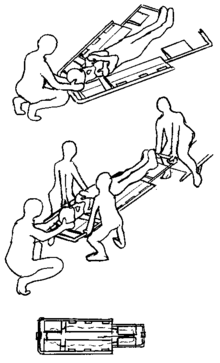Scoop stretcher
The scoop stretcher is an aid to rescue people who have had an accident and a possible fracture of the spine cannot be ruled out. It is a flat stretcher made of light metal or plastic that can be divided lengthways.
use
To pick up (" scoop up ") a patient, the scoop stretcher is separated into its two parts and it is carefully pushed under the patient from both sides, if possible without lifting or otherwise moving him. Then the two halves are fixed again with fasteners, the patient is fixed with straps, and the patient lies on a stable surface.
As a rule, the patient is then placed on a vacuum mattress to ensure gentle transport.
Due to its small size and light weight, the scoop stretcher is occasionally used to transport the patient in difficult situations, e.g. B. used in narrow stairwells. The scoop stretcher is equipped with straps and handles for this purpose. This procedure is gentler on the patient than using a sling . A scoop stretcher is not a life-saving appliance in the sense of a transport or lifting device. The scoop stretcher cannot replace a basket stretcher .
The scoop stretcher is in each ambulance and ambulance present. The scoop stretcher (called a scoop stretcher or orthopedic stretcher in America ) is hardly used in the American rescue service. The combination of scoop stretcher and vacuum mattress is replaced there by the spineboard (backboard).
In conjunction with a vacuum mattress, it is possible to turn a patient lying on their prone onto their back using the sandwich technique with little movement and in an axially aligned manner. With this method, the vacuum mattress is placed on the patient, the scoop stretcher is pushed underneath and fixed accordingly. After rotating around the horizontal axis, the patient lies on his back in the vacuum mattress.
Especially if a spine injury is suspected, it is used to rescue from cars or trucks in order to be able to free the patient lying down.
So-called combination stretcher ( Universal Rescue Stretcher , URS) combine a scoop stretcher and a carrying chair. Such a stretcher can be divided in both the extended and the folded state. This means that patients can be picked up and transported while sitting.
Historical
The Museum für Rotkreuzgeschichte Pinneberg dates a wooden specimen in its fund to the year 1910. Independently of this, the (new) invention of the scoop stretcher in 1943 is attributed to Wallace W. Robinson from Portland / Maine / USA. The first patent under the name "Splint-Stretcher-Frame" came into force on March 11, 1947, and it was still a frame with a hinge at the head end and an opening at the foot end.
The current shape, which can be opened at the top and bottom, was patented on July 6, 1970 by Elroy E. Bourgraf, owner of the stretcher manufacturer Ferno Washington Inc., and his colleague Kenneth R. Self.
Individual evidence
- ^ Catalog "150 Years of the Red Cross - 150 Museum Objects, Association of the German Red Cross Museums, published in 2013
- ↑ US patent number 2,417,378 for the "Splint-Stretcher-Frame" , accessed on March 11, 2010.
literature
- Flake, Runggaldier: Working techniques A – Z for the rescue service. Picture atlas rescue service . Elsevier, Munich 2008, ISBN 978-3437483202 .


